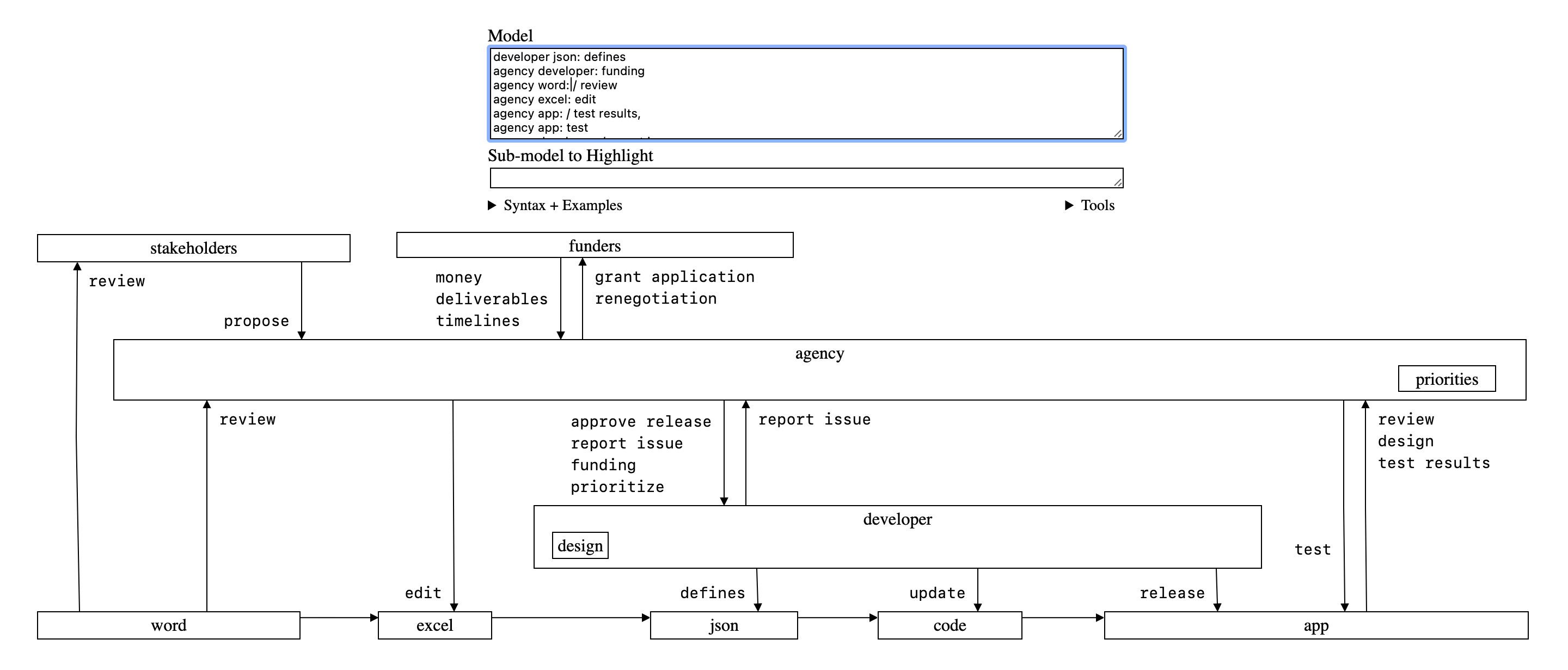Depict helps people establish and validate shared mental models of complex systems and situations via pictures drawn from shorthand notes: (demo)
agency situation shorthand notes
agency [ priorities ] developer [ design ] agency developer: approve release, developer app: release developer code: update agency developer: report issue, agency app: /review design stakeholders word: /review funders agency: money, deliverables, timelines / grant application, renegotiation developer json word excel json code app -: _ : _ : _ : _ developer json: defines agency developer: funding agency word: / review agency excel: edit agency app: / test results, agency app: test agency developer: / report issue, agency developer: prioritize stakeholders agency: propose
People who work with complex systems and situations often need to establish and validate shared mental models with partners in order to demonstrate understanding, build trust, and to set everyone up for success in future conversations.
Often, this process of establishing and validating shared mental models takes place by interviewing knowledgable people, taking notes, synthesizing notes into candidate pictures, and then reviewing the candidate pictures with stakeholders until everyone agrees that a satisfactory picture is available.
Unfortunately, many people find it hard to make these pictures in realtime as part of the interviewing process, let alone to make them legibly and comfortably. Specifically, conventional drawing tools often break the "flow" of the interview by requiring too much attention from the interviewer to use in realtime. People also often struggle to uncross arrows or to keep parts of their drawing from colliding, especially while editing text labels. Finally, the resulting drawings are brittle and are usually not meaningfully versioned or versionable such that people have trouble reusing and maintaining the resulting drawings over time.
Depict can drastically improve this "interview - record - synthesize - review" loop by:
- freeing interviewers' attention to improve and validate their understanding in realtime while maintaining flow
- enabling interviewers to concisely describe the players and interactions present in complex systems and situations via a shorthand notation specially developed for this purpose
- automatically drawing pretty, legible, maintainable pictures of models described by shorthand notes in realtime with minimal fuss, and
- automatically producing a transcript of the shared validated mental model developed so far which analysts can easily manipulate, version, reuse, and maintain.
depict is available for free online at https://mstone.info/depict/.
Alternately, on macOS and Linux, you can build and run depict locally using nix with flakes enabled to run:
nix run github:mstone/depict#desktopThis should produce a window similar to the one shown in the screenshot above.
(For more information on how to install and use nix, see https://zero-to-nix.com and https://mstone.info/posts/nix-tutorial/).
Depict helps people establish and validate shared mental models with partners by automating the process of drawing pictures of situations involving complex interactions from shorthand notes such as might be recorded by an interviewer or an analyst on a video-call (possibly screensharing depict to enable other participants to review and help improve the interview or analysis team's developing understanding).
In these notes, each line of input describes a new part of the situation (system) to be drawn.
In the resulting drawing, processes can be ordered vertically (a b), horizontally (a b -), or via nesting (a [ b ]).
Additionally, interactions between processes can be shown with an arrow labeled in the "forward" (a b: interaction) direction from a to b or with an arrow labeled in the reverse (a b: / interaction) direction on either horizontal and vertical arrows.
(In the convention which this shorthand was invented to describe, downward-directed arrows represent "control actions" or "authority" of one player over another, upward arrows represent "feedback", rightward arrows represent "requests" between peers, leftward arrows represent "results" or "replies", and nesting represents how interacting parts can be abstracted, how higher-level conceptual processes can be decomposed, or the fate-sharing relationship between "platforms" and the processes they host.)
For example:
person microwave food: open, start, stop / beep : heat
person food: eat
says:
- there are
person,microwave, andfoodboxes, personacts onmicrowave,microwaveacts onfood, and these interactions should vertically order these boxes- in the space between
personandmicrowave, there should be a downward arrow with three action labels,open,start, andstop, and an upward arrow with one feedback,beep, - in the space between
microwaveandfood, there is one action,heat. - finally, there is also a direct relationship between
personandfoodconsisting of the action:eat.
For more detailed examples, please see these articles:
depict offers an inline Syntax Guide with short examples of the depict shorthand input format.
Slightly formally though, the current depict input language roughly consists of:
| production | syntax | |
|---|---|---|
| abbreviation | ::= | name : expr |
| relations | ::= | name name ... [-] (: labels (/ / labels)?) |
| labels | ::= | label... for single-word labels |
| labels | ::= | label (, label)* for multi-word labels |
| nesting | ::= | [ model ] |
| alternatives | ::= | { model } |
| styling | ::= | relation @ styles |
Currently depict supports two builtin styles:
| style | analogous CSS |
|---|---|
| red | background-color: red; color: white; |
| hidden | display: none; |
This project is licensed under the MIT license.
Unless you explicitly state otherwise, any contribution you intentionally submit for inclusion in depict shall be licensed as MIT without any additional terms or conditions.




